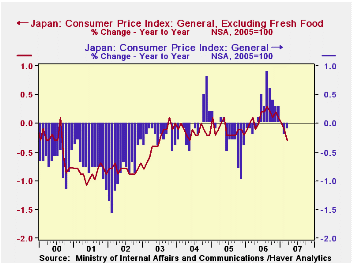 Global| Apr 27 2007
Global| Apr 27 2007Japan's Economy Hits Some Air Pockets; CPI Starts To Fall Again
Summary
Japan's economy appears in an uncertain position, according to a collection of data released this morning in Tokyo. What seem to be favorable trends turn out to be unsustainable, so evidence of growth is fleeting. Industrial [...]

Japan's economy appears in an uncertain position, according to a collection of data released this morning in Tokyo. What seem to be favorable trends turn out to be unsustainable, so evidence of growth is fleeting.
Industrial production perhaps surprised the most, falling 0.6% in March from February and slowing on a year-to-year basis to just 1.6% above March 2006, after gaining 3.1% in February and 4.8% for last year as a whole. Forecasters had looked for industry to raise production in March by an amount about equal to the decline that occurred. The losses in March were widespread across equipment and materials. 
Similarly, household living expenditures had perked up following a late summer decline, but they could not hold the newfound gains, and sank by 1.4% in March. They are now essentially flat with March a year ago. This is not, however, because there is significant weakness in labor markets. March employment was up only 10,000, but that followed a 420,000 increase in February; the numbers of persons employed are up 0.7% from March 2006, stronger than the 0.4% rises in each of the last three years. The unemployment rate has been steady at 4.0% for five consecutive months; a rate lower than this was last seen in the winter of 1998.
Perhaps most exasperating for Japanese government officials, the CPI has started to weaken again. We, as they, were excited over a turn toward rising prices just ahead of the Bank of Japan's rate increase last July. The year-on-year change in the CPI excluding fresh food -- the preferred "core rate" -- there, shifted to positive in March 2006, then after hesitating, it set a consistent trend of 0.2%-0.3% gains over much of the rest of 2006. This is not rapid, of course, but it gives business some badly needed pricing flexibility. Clothing prices, for instance, picked up, but then moderated in the most recent months. Furniture prices are falling more slowly than they were. But so far this year, the "ex fresh food" core has started to tilt lower. In February, it was down 0.1% on the year earlier and in March, 0.3%. Interpreting this is tough, considering it's one of the BoJ's main policy targets. The weakest categories this month are housing, which has declined all along, and transportation, particularly public transportation. Part of the adverse year-on-year comparison is also due to the acceleration of energy prices a year ago. Some of these items are administered prices and energy costs are, of course, burdensome, like a tax. 
So all of these things together: a sudden and unexpected drop in industrial activity, weaker household expenditures and skittish consumer prices facing a firm employment conditions -- make it hard to characterize the strength of Japanese markets and hard for policymakers to key their decision-making. A semiannual outlook released today (available here) featured a reduction in the consumer price forecast for the current fiscal year (ending March 2008) and suggested to many observers that it will be hard to raise interest rates anytime soon.
| JAPAN (Seas. Adj., % Change, ex as noted) |
Mar 2007
Feb 2007
2006 | 2005 | 2004 | ||||
|---|---|---|---|---|---|---|---|
| Mo/Mo | Yr/Yr | Mo/Mo | Yr/Yr | ||||
| CPI: General | 0.0 | -0.1 | -0.3 | -0.2 | 0.2 | -0.3 | -0.0 |
| ex Fresh Food | -0.1 | -0.3 | -0.2 | -0.1 | 0.1 | -0.1 | -0.1 |
| ex Food & Energy | -0.2 | -0.4 | 0.0 | -0.3 | -0.4 | -0.4 | -0.6 |
| Industrial Production | -0.6 | 1.6 | 0.7 | 3.1 | 4.8 | 1.1 | 5.5 |
| Employment | +10K | 0.7 | +420K | 0.5 | 0.4 | 0.4 | 0.4 |
| Unemployment Rate | 4.0 | -- | 4.0 | -- | 4.1 | 4.4 | 4.7 |
| Household Living Expenditures* | 98.4 | 0.1 | 99.8 | 1.1 | 98.1 | 100.0 | 100.8 |
Carol Stone, CBE
AuthorMore in Author Profile »Carol Stone, CBE came to Haver Analytics in 2003 following more than 35 years as a financial market economist at major Wall Street financial institutions, most especially Merrill Lynch and Nomura Securities. She had broad experience in analysis and forecasting of flow-of-funds accounts, the federal budget and Federal Reserve operations. At Nomura Securities, among other duties, she developed various indicator forecasting tools and edited a daily global publication produced in London and New York for readers in Tokyo. At Haver Analytics, Carol was a member of the Research Department, aiding database managers with research and documentation efforts, as well as posting commentary on select economic reports. In addition, she conducted Ways-of-the-World, a blog on economic issues for an Episcopal-Church-affiliated website, The Geranium Farm. During her career, Carol served as an officer of the Money Marketeers and the Downtown Economists Club. She had a PhD from NYU's Stern School of Business. She lived in Brooklyn, New York, and had a weekend home on Long Island.





